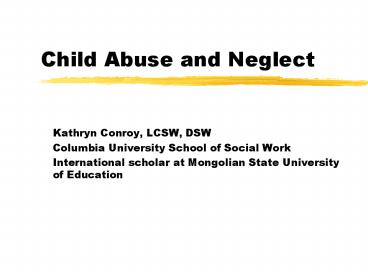Child Abuse and Neglect - PowerPoint PPT Presentation
1 / 22
Title:
Child Abuse and Neglect
Description:
Child Abuse and Neglect. Kathryn Conroy, LCSW, DSW. Columbia University School of Social Work ... Committee to Prevent Child Abuse. Bureau of Justice ... – PowerPoint PPT presentation
Number of Views:171
Avg rating:3.0/5.0
Title: Child Abuse and Neglect
1
Child Abuse and Neglect
- Kathryn Conroy, LCSW, DSW
- Columbia University School of Social Work
- International scholar at Mongolian State
University of Education
2
Why do parents maltreat their children?
- Psychopathology
- Environmental Stress
- Social Learning
3
Psychopathology
- The primary cause of the abuse resides within the
parents personality or character traits - Mental Illness
4
Environmental Stress
- Poverty, racism, unemployment, occupational
stress, marital stress - Predisposition of society to be violent toward
all children. - Alcoholism and addiction
5
Social Learning
- Ignorance regarding child rearing and child
development. - Lack of learning to be effective parents
including affective and emotional lessons. - Learning of actual maladaptive behaviors.
6
Scope of the Problem
- 3 million reports of CA/N made last year.
- 3 million reports involve 5.6 million children
- US Department of HHS estimates incidence to be 3
times the number reported.
7
Incidence
- (all statistics in this overview are from
HHS/ACYF 2004 the most recent year available) - 50,000 allegations per week
- 3 million referrals in 2004
- 3 million referrals 5.5 million children
- National rate 42.6 per 1000 children
(compared to 39.1 per 1000 in
2003)
8
Types of Maltreatment
- Neglect 62.4
- Physical Abuse 17.5
- Sexual Abuse 9.7
- Emotional Maltreatment 7.0
- Medical Neglect 2.1
9
Distribution by Gender
- Males account for 48.3 of all cases reported
- Females account for 51.7
- Males account for 0.4 cases of sexual abuse per
1000 children in the population. - Females account for 1.7
10
Distribution by Age of CA/N
- 0 3 years of age 16.1 per 1000
- 4 - 7 years of age 13.4 per 1000
- 8 11 years of age 11.7 per 1000
- 12 15 years of age 10.7 per 1000
- 16 17 years of age 5.9 per 1000
11
Distribution by Race
- 53.8 of all victims are white
- 25.2 are African American
- 17.0 are Hispanic
- 2 are American Indians/Alaska Natives
- 1 are Asian/Pacific Islanders
12
Perpetrators
- 57.8 female average age 31
- 42.2 males average age 34
- 83.4 are parents and 90 of them are
biological parents - 10 are unmarried partner of parent, legal
guardian or foster parents - 6.5 are other relatives
13
Sexual Abuse
- 1 in 4 girls by age of 18
- 1 in 6 boys by age of 18
- 1 in 5 children are solicited sexually while on
the internet - 30 40 by a family member
- 50 by someone they know
- 10 by strangers
14
Sexual Abuse continued
- Median age 9
- 30 of victims disclose to no one
- 75 disclose accidentally
- 20 recant
- Children fabricate only 0.5 of the time
15
Distribution by Age of Child Fatalities
- 0 3 years 78. of all child fatalities
- 1 year 15.6
- 2 years 12.6
- 3 years 6.9
- 4 7 years 10.2
- 8 11 years 5.4
- 12 17 years 5.7
- The younger they are the more at risk.
16
Reports by Source
- Educational Personnel 16.3 of total
- Legal, Law Enforcement 16.0
- Social Service Personnel 11.6
- Medical Personnel 8.2
- Mental Health Personnel 3.0
- Day Care Foster Care Providers 1.7
- Anonymous 9.1
- Other Relatives 8.1
- Neighbors 5.8
17
Reports by Disposition
- Substantiated 25.7
- Unsubstantiated 57.7
- Indicated 4.1 (probably substantiated but
could not be proved) - Closed with no finding 1.6
- Other 11
18
Remedy/Response
- Education
- Prevention
- Intervention
19
Education
- Of the general public
- how to identify
- what to do
- where to go
20
Prevention
- identify early
- target those with risk factors (poverty,
substance abuse, domestic violence, mental
illness, etc.) - involve the community
21
Intervention
- break down isolation
- ameliorate risk factors
- Repair
22
Sources (all available on web)
- Health and Human Services
- Administration for Children and Families
- Childrens Bureau
- National Committee to Prevent Child Abuse
- Bureau of Justice Statistics
- FEDSTATS

